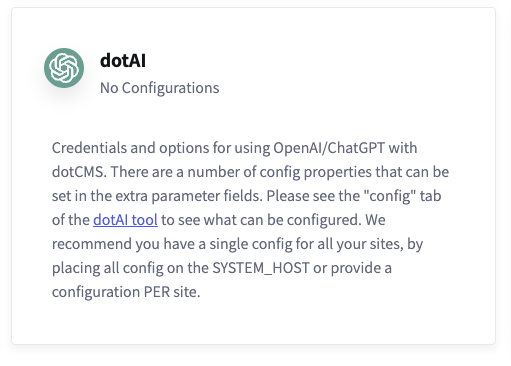The dotAI plugin integrates powerful AI tools into your dotCMS instance, allowing new horizons of automation — content and image generation, semantic searches, workflows capable of handling nitty-gritty procedures like content tagging, and more.
Currently, these integrations leverage the services of OpenAI. In future iterations, the choice of AI service provider will become a configurable option.
This plugin is only for versions prior to dotCMS 24.04.05, at which time dotAI became a core feature. Prior versions must nevertheless still satisfy the following requirements:
- dotCMS Enterprise Edition, as this plugin has both Workflow and App components, both of which are Enterprise only;
- An OpenAI API key, obtained separately.
- Postgres 15 with the pgvector extension installed.
- An easy way to bootstrap this is to pick the latter up with
docker pull pgvector/pgvector; ensureimage: pgvector/pgvectorappears underdbin yourdocker-compose.ymlfile. - In other cases, see the dotAI documentation section on self-hosted requirements.
- An easy way to bootstrap this is to pick the latter up with
Building and Deploying
You can find the plugin's source at its GitHub repository; clone it, and then run ./gradlew jar in its root directory to build the JAR file under com.dotcms.ai/build/libs.
Upload the file via DevTools → Plugins. Once it's uploaded and confirmed as active, head to System → Apps to configure it.
As with any App integration, determine whether you're configuring the dotAI plugin for a single site or the System Host — i.e., all sites. Then, add your OpenAI key to the appropriate API Key required field.
Configuration and Use
For detailed information on the plugin's contents, configuration, and usage, please see the dotAI Feature documentation.




